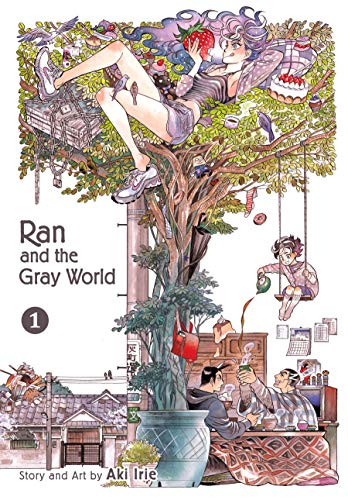By Aki Irie. Released in Japan as “Ran to Haiiro no Sekai” by Enterbrain, serialized in the magazine Harta. Released in North America by Viz Media. Translated by Emi Louie-Nishikawa.
Sometimes you really do just read a book for the art. Oh, there’s other reasons to read Ran and the Gray World. The lead heroine is cute and rambunctious, and the plot spirals out from her ability to get into trouble and also her ability to transform into an older version of herself. Her family seems to consist of sensible men and eccentric but very powerful women, and her older brother is usually stuck trying to fix Ran’s messes. There’s some great humor, particularly with Ran’s interactions with a rich playboy. But let’s face it: You read this title for the gorgeous art. Every panel seems chock full of stuff, but it draws the eye in and makes you want to take your time reading it. It’s the type of story that you say is ‘crafted’ rather than written. And it makes me want to read more, despite the possibility of a trope from many other ‘young girl magically grows into adult’ stories cropping up.
We are introduced in the first chapter to Ran, a young tomboyish girl who is very interested in finding her shoes. We also meet her brother Jin, who has hidden said shoes for a reason. They’re shoes that help Ran to age about ten years, appearing to be a young woman but still with the mentality of a young child. This is a fairly common theme, especially in magical girl Japanese manga (Tezuka did it at least once, I know), but Ran’s not aging up to help save the world from bad guys – she’s just curious about everything, and wants to have fun. Ran lives at home with her brother and father, and at first I assumed that her mother had passed away, but I’m wrong – her mother is SO powerful she is needed to restrain what appears to be a door to hell, and thus can’t be all that involved with her daughter’s life, though she does write. And so Ran does things like taking a train (and hitchhiking) to try to find her, or attempting to learn to fly, etc.
When I say I read the manga for the art, I don’t mean that it’s filled with detailed backgrounds and the like, although those pop up as well (love the shot of Ran’s messy room). But the art I meant is more composition, the way the creator draws your eye in. The double-page spread of Ran in her adult form, shoes in deep close-up. The expressions on her face, which shows that she’s a clever but naive girl, who one day is likely going to be more powerful than her mother. And the endless grumpiness of her brother Jin, who did not sign up to be a minder but is anyway. I will warn of one ongoing plotline – Ran (in adult form) runs into an eccentric rich guy, who is immediately charmed by bother her looks and her seeming magical abilities. This is also a staple of “age up” titles, but I hope that it remains innocent, as Ran really is a young kid (and also, the guy is sort of a jerk). I am definitely interested in more of this series, and I note the author also has another title out next year from Vertical. One to watch out for.

